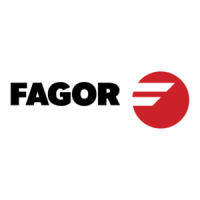·48·
Programming manual
CNC 8055
CNC 8055i
3.
AXES AND COORDINATE SYSTEMS
·M· & ·EN· MODELS
SOFT: V02.2X
Coordinate programming
3.5.2 Polar coordinates
In the event of the presence of circular elements or angular dimensions, the coordinates of the
different points on the plane (2 axes at the same time), it may be easier to express them in polar
coordinates.
The reference point is called Polar Origin, and this will be the origin of the Polar Coordinate System.
A point on this system would be defined by :
• The RADIUS (R), the distance between the polar origin and the point.
• The ANGLE (Q), formed by the abscissa axis and the line which joins the polar origin with the
point. (In degrees).
The values R and Q are absolute or incremental depending on whether you are working with G90
or G91, and their programming format will be R5.5 Q±5.5. The radius value must always be positive.
The values R and Q are incremental and their programming format will be R±5.5 Q±5.5.
The R values may be negative when programming in incremental coordinates; but the resulting value
assigned to the radius must always be positive.
When programming a "Q" value greater than 360º, the module will be assumed after dividing it by
360. Thus, Q420 is the same as Q60 and Q-420 is the same as Q-60.
Programming example assuming that the Polar Origin is located at the Coordinate Origin.
Absolute coordinates:
G90 X0 Y0 ; Point P0
G01 R100 Q0 ; Point P1, in a straight line (G01)
G01 R50 Q30 ; Point P2, in an arc (G03)
G01 R50 Q30 ; Point P3, in a straight line (G01)
G03 Q60 ; Point P4, in an arc (G03)
G01 R100 Q60 ; Point P5, in a straight line (G01)
G03 Q90 ; Point P6, in arc (G03)
G01 R0 Q90 ; Point P0, in a straight line (G01)

